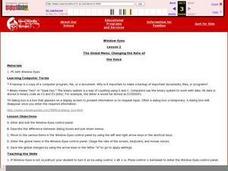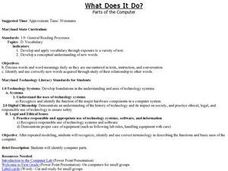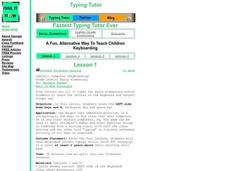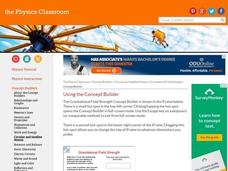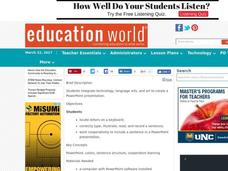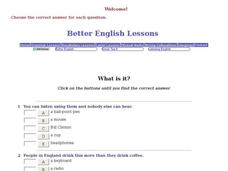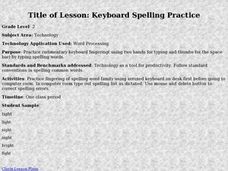Curated OER
The Global Menu: Changing the Rate of the Voice
Young scholars examine the Windows-Eyes control panel by using dialog boxes, pull-down menus, left and right arrow keys, and shortcut keys. They also change the rate of the screen, keyboard, and mouse voices.
Curated OER
What Does It Do? Parts of the Computer
This is a nice introduction for first graders to parts of the computer. It includes several resource links to PowerPoints to show the class. There is one activity for the class to do. This is a basic introduction, and could definitely be...
Curated OER
Plants Scavenger Hunt Activity
The hunt is on! Provide young botanists with a list of eighteen plant-related questions and let them loose as they search for answers on corresponding fact cards. Perform this activity in the classroom or use it as an opportunity to take...
Physics Classroom
Color Pigments
Objects contain pigments that selectively absorb a wavelength of light, and our eyes only observe a very small range of these wavelengths. Scholars apply these two facts to three different activities. They identify the pigment in an...
Curated OER
Key Vocabulary Words!
Third graders use home row keyboarding techniques to type appropriate vocabulary words. This well thought out lesson plan presents many effective ways to teach keyboarding skills to your students.
Curated OER
Computer (Keyboarding)
Students practice typing the letters on the left side of the home row of keys. They complete time tests and examine their results. They discover words from those letters as well.
Music Fun
Practice Boards
FACE it. Every Good Boy Deserves Fruit! (And so do girls.) Provide young musicians with music worksheets that enable them to practice musical notation. The six boards included in the packet are templates that focus on notes, rests,...
Curated OER
Halloween Tales
At the beginning of this Halloween activity, learners generate a list of spooky characters and words that they will use when creating their original stories. Teams of 3-4 members create the stories together. The activity includes a handy...
Benjamin Franklin Tercentenary
From Ben’s Pen to Our Lives
What would Ben do? Jumping off from the pseudonymous letters Ben Franklin fooled his older brother into publishing when he was still a teenager, young literary lovers dive into acting, writing, and addressing a local issue with wit and...
Pearson Longman
Emotions Reading
Explore the many types of feelings and how people express them with a lesson compiled of kid-friendly activities that spark critical thinking, self-reflection, and reinforce language and writing skills. Scholars delve into the variety of...
Physics Classroom
Charge Interactions
Has your class been repelled by your previous magnetism lesson plan? Try a fun interactive instead! The activity, part of the Static Electricity series, challenges scholars to infer the charges of a group of magnets based upon their...
Physics Classroom
Gravitational Field Strength
Budding scientists fall hard for a gravitational field strength activity! Physics pupils compare the masses and distances relative to the center of planets using an interactive from a Circular and Satellite Motion series. Individuals...
Curated OER
Formatting Fun
Launch this activity by saving the provided Formatting Fun template on your classroom or library computers. Young learners can then practice formatting basics for use in writing activities. Exercises include practice in highlighting...
Curated OER
Let Your Fingers Do The Walking
Students build an awareness of using correct finger positions for typing in this instructional activity. They also review the home row of the keyboard. Internet resource links are included to reinforce home row typing skills. Students...
Curated OER
Musical Phrase Completion
Students get to encounter simple musical notations, basic keyboarding and improvisation. Students exercise on creative thinking skills. Students create their own musical notes.
Curated OER
Computer Parts
Students observe PowerPoint presentation explaining the parts of a computer and discuss the monitor, keyboard, mouse and CPU unit. They create index cards, with definitions and place them on the word wall. Individually, students visit...
Curated OER
My First PowerPoint Presentation
Student practice locating letters on the computer keyboard while correctly typing, reading and recording a sentence. They work in groups while creating a PowerPoint presentation by having each student insert a sentence.
Curated OER
Keyboard centers with Music You Can Read
Students play the letters provided in the format "Keyboard/Xylophone/Tone Bells" with the intention of using the "Music Only" format as skills progress. They study fingerings and chords when appropriate to skills.
Curated OER
ESL: Riddle Vocabulary Activity
In this ESL vocabulary worksheet, students read a description of an item, then choose the correct item being described. Page has links to additional activities.
Curated OER
Keyboard Spelling Practice
After teaching kids the hand placement generally used for typing, give them a short list of common words to practice with. They type tight, light, sight, night, bright, and fight as fast and accurate as possible.
Code.org
Star Wars: Building a Galaxy with Code
Welcome to the code side. The interactive lesson introduces coding in a game format with familiar characters. Young computer experts learn to develop code to control the interaction of the characters in the game. The activity ends with...
Physics Classroom
Total Internal Reflection
Scholars work through three different activities applying their knowledge of total internal reflection (TIR). First, they simply identify which diagrams create TIR and which don't. Next, they match different types of boundary behaviors...
Curated OER
Dragonwings: Evaluate Chapters 10-12
As your class finishes the novel Dragonwings, use these culminating projects. A vocabulary list is given for chapters eleven and twelve and either an epitaph or letter activity concludes the book. The final project consists of creating a...
Beauty and Joy of Computing
Sprite Drawing and Interaction
Discover how to program objects to move on a screen. In the second lab of a five-part unit, each learner uses block instructions to program a sprite to follow their mouse (cursor). They investigate how to use these same block...
